Tuesday, February 28, 2006
Monday, February 27, 2006
Between A Moist Spot And A Wet Place
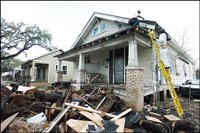 This is the reaction by FEMA to people deciding not to raise their homes to a level above the federal governments forthcoming base flood elevations. The problem is that the new flood maps haven't been released yet.
This is the reaction by FEMA to people deciding not to raise their homes to a level above the federal governments forthcoming base flood elevations. The problem is that the new flood maps haven't been released yet.
This puts homeowners between a rock and a hard place. You see, FEMA will ask may people to spend a lot of money to raise their homes but can't tell who needs raising or how high. In the meantime, local governments are encouraging people to return to their neighborhoods or else they will be deemed non-viable.
Many homeowners, however, said they have little choice: Raising their houses would cost too much. Estimates for elevating a house start at $20,000 and some exceed $100,000. FEMA offers as much as $30,000 toward such projects, but many homeowners said that amount would cover only a fraction of their costs.Therein lies their dilema. But where homes must be rebuilt from the ground up, history offers us a solution.
Some of the oldest portions of the city, such as the French Quarter and the Garden District, are built on higher ground, and many older New Orleans houses are built high enough that the front door is as many as 10 steps above the sidewalk. Many of these fared best during the Katrina floods last summer.Rebuilding homes as raised cottages instead of the ubiquitous ranch house offers a few advantages.
"Prior to the '50s and '60s, most of the housing in New Orleans was built raised above the ground," Tulane's Kroloff said. "The regular flooding of New Orleans didn't threaten them."
- The raised cottage will put many homes that flooded above the base flood elevation.
- They will recreate a type of home that is common throughout much of the older parts of New Orleans.
- This style of home is seeing a newfound populararity in some of the newer developments in more suburban areas.
- Raised cottages will, to some extent, bring back some of the charm that exists in more historic parts of New Orleans.
designed
3:02 PM
0
critiques
![]()
By The Numbers
The Advocate.com compiles the numbers on how Katrina affected Louisiana.
- POPULATION: An estimated 189,000 New Orleans residents have returned, compared with around 500,000 pre-Katrina.
- DEATHS: 1,080 in Louisiana.
- MISSING: Nearly 2,000 listed as missing by the Find Family National Call Center.
- DESTROYED HOUSES: More than 215,000. Total housing units lost, including apartments, is 1,847,181.
- PROPERTY AND INFRASTRUCTURE LOSSES: $75 to $100 billion.
- DEBRIS: Katrina created 60.3 million cubic yards; 32.1 million cubic yards had been removed as of February.
- BUSINESSES: Of 81,000 impacted businesses, 42,000 have fully reopened; 18,700 were destroyed.
- TAX REVENUE: $549 million lost (including gambling, sales and income taxes.)
- SCHOOLS: More than 835 schools damaged statewide. Only 20 out of 128 public schools have reopened in New Orleans; 83,821 of 244,608 college students statewide were displaced. Of the displaced college students, only 16,480 have re-enrolled in state.
- JOBS: More than 220,000 jobs lost.
- WETLANDS: More than 100 square miles of wetland destroyed by storm surge.
- HOSPITALS: Katrina closed eight of 16 hospitals in the New Orleans’ area, reducing the number of hospital beds from 4,083 to 1,760.
- ELECTRICITY: A total of 189,000 households and businesses received electricity from Entergy New Orleans pre-Katrina, compared with between 65,000 to 70,000 today.
- GAS: A total of 145,000 customers in New Orleans received natural gas service from Entergy New Orleans before Katrina. Between 40,000 to 45,000 are using the service today.
- ESTIMATED DAMAGE TO POWER INFRASTRUCTURE: $275 million in infrastructure repairs in New Orleans.
designed
10:42 AM
0
critiques
![]()
Mardi Gras Mambo
Mardi Gras crowds are smaller this year but just the fact that we're having a Mardi Gras celebration and visitors are coming in is a good sign indeed.
Bloomberg.com writes... The city is smaller, most parades are smaller, the crowds are smaller and the party itself is shorter. Yet for those who love Mardi Gras, passing up this chance for normalcy in a city where whole neighborhoods are still dark would have been as unthinkable as abandoning New Orleans itself.

designed
10:20 AM
0
critiques
![]()
Zip-A-Dee-Do-Da
 Having a 701 zip code in Jefferson Parish is causing many inconviencences for mail recipients.
Having a 701 zip code in Jefferson Parish is causing many inconviencences for mail recipients.
...along with residents of high and dry Harahan, Elmwood, Jefferson and Algiers -- find themselves still part of the periodicals embargo for New Orleans, where the damage was more significant.One would think that the Post Office would be more specific about which zip codes are embargoed.
The good news is that New Orleans' main post office opened last week.
The downtown area post office is offering retail services, along with post office boxes, and delivery operations for three zip codes will return to the building in the next few weeks, said Postal Service spokesman David Lewin.Maybe the Post Office needs to add "hurricane" to its credo.
designed
9:20 AM
0
critiques
![]()
Sunday, February 26, 2006
Let's Dance
 Many residents of flooded-out neighborhoods are unhappy about the lack of effort to restore their homes after Katrina. But some are understadably in a waiting game with the government.
Many residents of flooded-out neighborhoods are unhappy about the lack of effort to restore their homes after Katrina. But some are understadably in a waiting game with the government.
...those who sit tight as they hope for a buyout or demolition program are quite logical: "They are doing something. They are conserving their resources and waiting for the government to do something."On the other hand...
...owners should, if they are able, quickly take steps to clean up and secure their properties -- in a good-neighbor spirit.This all goes back to my earlier arguments that state and local governments need to get on the ball and make a decision but everyone is waiting on someone else.
Homeowners are waiting on local government to decide if they will be allowed to rebuild as well as the amount of the buyout - if there is one. Local governments are waiting to see which areas show signs of revitalization.
The state government is waiting to find out how much money it will get from the federal government before it comes up with a plan on how to give it away to the well connected and the federal government is waiting on a plan from the state to show that such a thing will not happen.
These people are like a bunch of seventh graders at their first dance. The boy is afraid to ask the girl to dance unless he knows she will say yes. The girl is afraid to let the boy know that she would like to dance with him. In the meantime, their parents have their hands in the air saying 'Somebody do something.'
designed
9:51 PM
0
critiques
![]()
Light At The End Of The Tunnel Or Is That A Train?
 Today's Times Picayune carries an excelent article on the status of the recovery effort in the New Orleans area. According to the peice, people are starting to get a good idea of what areas are looking at recovery and which aren't.
Today's Times Picayune carries an excelent article on the status of the recovery effort in the New Orleans area. According to the peice, people are starting to get a good idea of what areas are looking at recovery and which aren't.
Also addressed are methods that the government is taking to promote recovery.
Kroloff believes a key to the plan's ultimate success will lie in what sorts of incentives the government can offer to make the plan's vision a reality. For instance, he said the state's plan to offer a better deal to homeowners who resettle in Louisiana is a smart one. On the local level, he believes the city may be able to package blighted and abandoned property in ways that make it attractive to investors. Washington, D.C., underwent a remarkable turnaround in the past decade through the use of such local tax incentives, he said.
"The great thing about tax incentives and development incentives is they don't rob the treasury," Kroloff said. "You're talking about properties that have no tax value now. I really hope we pull all the incentive packages and the planning on the table at the same time, and say, 'Let's make this better than it was before.'
"Wouldn't it be nice if five years from now we were talking about how New Orleans is busting at the seams instead of busted?"
I agree that tax incentives should be made to those who resettle but the government needs to address the financial straits that flooded homeowners have been placed in because of the negligence of the Corps of Engineers.
The fact is that everyone in the area will pay a price. Even those that did not flood will be looking at higher insurance premiums. Even me personally am expecting my flood insurance to increase even though I built on the edge of a flood plain and built higher than the mimimun above BFE (Base Flood Elevation).
So not only should the federal government bail out those who lost property but the insurance industry as well for they took a financial hit too, but as usual, the average Joe is left to pay the piper.
designed
9:31 PM
0
critiques
![]()
Saturday, February 25, 2006
Go MR-GO A No Go
 Despite local area residents wishes that the MR-GO be converted to a landfill, the federal government is planning on installing flood gates at the Industrial Canal and the MR-GO.
Despite local area residents wishes that the MR-GO be converted to a landfill, the federal government is planning on installing flood gates at the Industrial Canal and the MR-GO.
Although the MR-GO proposal is not all that area residents have been asking for, the addition of the Industrial Canal locks have to make people happy.
This is the first time since Katrina slammed the area that President Bush and the Army Corps of Engineers have formally proposed building gates to beef up protection for the New Orleans area from the ravages of another hurricane.
The proposal calls for building one set of gates where the Industrial Canal flows into Lake Pontchartrain and a second set somewhere west of the juncture of the Mississippi River-Gulf Outlet and the Intracoastal Waterway.
New Orleaneans will probably welcome the news about MR-GO but I doubt it offers any solace to the residents of lowers Plaquemines Parish. You see, MR-GO levees breached in many locations worsening flooding conditions in areas like Meroux and Violet. However, if the funding for the locks also includes strengenthing the levees of MR-GO, the this news will be welcome indeed.
As for the inclusion of the Industrial Canal in the lock system, this can only be good. And fortunately, the construction won't stop there.
Other enhancements to the region's battered hurricane protection system include construction of permanent pump stations at the lake for three New Orleans outfall canals, armoring to protect especially vulnerable sections of levee from scouring, construction of 23 miles of new levee in Plaquemines Parish, restoration of coastal wetlands and ecosystems especially hard-hit by Katrina, and "storm-proofing" individual pump stations.Let's just hope that these projects aren't going to built up to the standards of the 17th Street Canal.
designed
11:19 PM
0
critiques
![]()
Rotten To The Corps?
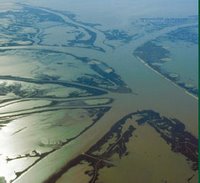 No, this is not a post about Louisiana politics, but it might as well be.
No, this is not a post about Louisiana politics, but it might as well be.
The Interagency Performance Evaluation Task Force released a report on Friday where it recommends that the whole levee system in south-east Louisiana is evaluated, not just where the breaches occured. Because if the repaired sections are made stonger, other sections left untouched will be more likely to break in case of a storm.
According to The Advocate,
The report encourages researchers to look at the whole system, not just the failures.This makes a lot of sense. So much sense in fact that one wonders why the Corps hasn't been inviestigating the whole levee system from the get-go.
“While a few places failed, that doesn’t mean other places won’t fail in the future,� said Wayne Clough, committee chairman for the National Academy and president of the Georgia Institute of Technology in Atlanta.
There could be sections of levee that were close to failing but didn’t simply because another section failed first and relieved the pressure, Clough said.
In addition, the corps is rebuilding damaged and failed sections of levee in ways that make those sections stronger and more stable, he said.
That could just change the locations of future levee failures, which is why the “big picture� approach is important, Clough said.
designed
9:39 PM
0
critiques
![]()
Friday, February 24, 2006
Gone Daddy Gone, Barge Is Gone
 This barge has been sitting in the Lower Ninth Ward near the levee breach sinch August 29. Now efforts have begun to remove it.
This barge has been sitting in the Lower Ninth Ward near the levee breach sinch August 29. Now efforts have begun to remove it.
A marine salvage company hired by the vessel's owner, Ingram Barge, used industrial strength inflatable air bags to lift the 200-by-35-foot barge off the ground Thursday and place it on Jourdan Avenue, enabling lawyers, engineers and other experts to examine every inch of the steel.If it takes six months to remove a barge, how long will it take to kick self-serving politicians out of office?
Another paragraph give us an indication:
The barge's prime role now is as a piece of courtroom evidence, and the salvage crew about to cut it apart must follow a federal judge's order on which pieces will end up in storage, and what will be discarded as scrap, as several post-Katrina lawsuits loom on the docket.An just to give you an idea of the lengths our leges will go to protect themselves, the first amendment is not even an obsticle; acording to Louisiana Political News Service,
House Bill 23 by Rep. Danny Martiny would penalize ($500 or 6 months in jail) people who criticize elected officials (read, members of the legislature) in a way to affect their vote or actions.Oh what a woderfull state we live in.
designed
4:33 PM
0
critiques
![]()
The Incredible Shrinking City?
 The State.com (SC) editorializes that the size of the city of New Orleans has to shink. What it doesn't say is how. It does recommend that certain neighborhoods should be converted back into wetland to avoid future similar flooding.
The State.com (SC) editorializes that the size of the city of New Orleans has to shink. What it doesn't say is how. It does recommend that certain neighborhoods should be converted back into wetland to avoid future similar flooding.
Boy howdy, do these journalists have a grasp for the obvious?
When I read the headline I was expecting some concrete recommendations on how to do it. That's like telling someone trying to invent a perpetual-motion machine to just build it. Easy to say, but when your dealing with the laws of physics, doing is much more difficult.
So to make-up for the lack of insight from The State, here are some suggestions to deal with the laws of politics.
- New Orleans should simply unincorporate most or all of New Orleans East. Bayou Sauvage Wildlife Refuge has no business being inside the city limits. Those living in New Orleans East will not like being unincorporated at first, but it simply means that the parish will take over those services that the city currently provide. In other words, be more like Jefferson Parish.
- If you want to convert neighborhoods back to wetland, don't be impatient about deciding where they should be. Recovery will be long term so let's plan long term. City officials certainly can wait to see which area make a substantial recovery. We may find some areas with few residents. If those residents decide they don't like living in "ghosts towns", the government coud offer to buy them out. Homeowners migh be happy with this arrangement. If the government tried to force people out of their homes, they will be asking for nothing but trouble.
- Some City Council members will not take kindly to having their district being eliminated and will likely put up a fight to maintain the status quo. A city-parish form of government might be a good comprise to get some council members on board.
designed
3:38 PM
0
critiques
![]()
Tuesday, February 21, 2006
Christmas In Biloxi
Biloxi Winter Wonderland is now available on the web.
designed
4:35 PM
1 critiques
![]()
Two For You And One For You
 The Louisiana Recovery Authority has finally come out with a plan for buying out homeowners who were flooded due to Hurrican Katrina but one aspect of the plan will be about as popular as Michael Brown at City Hall.
The Louisiana Recovery Authority has finally come out with a plan for buying out homeowners who were flooded due to Hurrican Katrina but one aspect of the plan will be about as popular as Michael Brown at City Hall.
The key difference between the state and city plans lies in their treatment of people who have moved out of state and do not plan to return. The state proposal would give this group 60 percent of the prestorm value of their homes, compared with 100 percent under the city plan.This part of the state's proposal smacks of paternalism. What good are Louisiana residents if they aren't around to vote for the current officeholders.
Second, it's no damn business of the state where an individual wants to live. Governor "Drew a" Blanco needs to stop trying to reclaim her position of Queen Bee and looking out for the well being of her constituents.
Another proposal of "Drew a" Blanco that should go the way of New Orleans government consolidation is her wish that homes that were located in a flood-plain be short-changed.
Blanco's proposal would consider whether a house was inside or outside the flood plain, cutting by 30 percent the aid available to those inside the plain who did not have flood insurance. For those in that group who want to be bought out but stay in the state, the maximum assistance would be $105,000.Whether or not the home was situated in a flood-plain should not matter in this instance. Most people flooded as a result of government negligence and not Mother Nature. If the flood-protection walls had not failed, few homes in New Orleans and Jefferson Parish would have flooded and the government should not get off scott free at the expense of ordinary citizens who belived that the government would protect them from a home like Hurricane Katrina.
designed
1:26 PM
0
critiques
![]()
Monday, February 20, 2006
We're Moving On Up
 The price for homes in the New Orleans area have skyrocketed after the storm according to a story in the Times-Picayune.
The price for homes in the New Orleans area have skyrocketed after the storm according to a story in the Times-Picayune.
During the final four months of 2005 -- the months after Katrina -- the average sale price in the metropolitan area was $215,769, or 21 percent higher than the average price of all homes sold in 2004. In St. Tammany Parish, where nearly half of all the post-Katrina sales have occurred, the average sales price climbed to $225,156, which is 20 percent higher than in 2004.This article reflects remarks I made in January here. Especially this remark in the article:
"They're coming from Chalmette, Lakeview, Gentilly, the flooded areas," said Al Palumbo, broker manager for Latter & Blum's office on Elysian Fields Avenue. For some, Katrina has presented an opportunity to buy into neighborhoods they've longed to live in. The historic neighborhoods of Bywater and Marigny, for example, are in high demand, Palumbo said.And my comment:
2. Moving on. Where houses flooded badly, the owners are looking to unload their damaged homes for a song to either move to higher ground - see above - or relocate altogher. This is creating opportunities for former residents to move back to the city.My wife and I drove through the Old Metairie Country Club neighborhood a couple of weeks ago and were astonished at the number of of for sale signs. Remember, Old Metairie has the highest property values in the state and Old Metairie Country Club is the most expensive in Old Metairie. It's also VERRRRY nice. What I also noticed was the almost total lack of rebuilding in that area compared to other areas of similar property value.
Why that is I have no idea but in other high-priced neighborhoods, home sales are quite brisk.
In Lakeview, however, where nearly every home flooded, some sales are moving forward as investors buy properties ripe for rebuilding. Before Katrina, homes in Lakeview sold for an average of $300,000. During the final four months of 2005, the average sales price for that area fell to $162,000, based on the 14 homes that sold during that period.This is probably due to people hoping to move up to nicer neighborhoods for half the cost.
If one can deduce the demographics of this real-estate activity, I believe it shows that the middle-class and upper middle-class are mostly staying in the city while the lower-class and much of the upper-class do not plan or can't return. This may reverse the economic decline that the city has been suffering for four decades as I explained here and corbusier here at Architecture and Morality.
In the days following the storm, commentators stated that New Orleans will be more white and more gentrified in the future. Data seems to indicate that it will be more white but I'm not sure about gentrified. It looks like it will be more middle-class and that is a good thing for the future of New Orleans.
designed
5:27 PM
0
critiques
![]()
Friday, February 17, 2006
Reinventing The Wheel
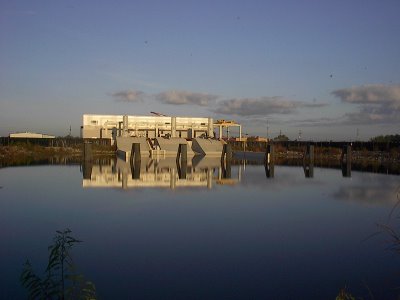 The Corps of Engineers is looking for ways to protect New Orleans outflow canals from storm surge as well as maintaining a way for rain water to flow out into Lake Ponchartrain. Currently the Corps is in the process of building temporary sluice gates to prevent strom surge out of the canals.
The Corps of Engineers is looking for ways to protect New Orleans outflow canals from storm surge as well as maintaining a way for rain water to flow out into Lake Ponchartrain. Currently the Corps is in the process of building temporary sluice gates to prevent strom surge out of the canals.
The problem is that when the gates are closed during a storm, rain water has no way to escape.
Are these people blind? They need to take a ride a few miles west along the shore to the canals in Jefferson Parish. Unlike Orleans, Jefferson Parish's canals are not open to the lake, rather, they are dammed at the lake with a large pump station atop the levee like the one pictured above.when the gates are closed against surge — and especially during a rainy, slow-moving storm — there could be interior flooding because pumping capacity will be greatly diminished.
Although Pump Station 6 can move water at the rate of about 10,000 cubic feet per second, the gates will be equipped with only one-tenth of that pumping capacity by June 1. Later in the season, the corps hopes to have tripled that number with the addition of more temporary pumps.
The main defference between the proposed Orleans canals and the Jefferson canals is that Orleans canals will be open to the lake except when storms approach. I can't understand why pumps wit the same cummulative capacty of the pumps that divert water the canals cannot be placed atop the levee to move water into the lake.
Keep in mind, there were no levee breaks in Jefferson Parish. Flooding only occured because;
- Flood waters from the 17th Street Canal spilled over into parts of Old Metairie.
- Parish President evacuated pump operators to Washington Parish forcing the shutdown of the pumps.
designed
11:13 PM
1 critiques
![]()
A Piece Of The Pie
 Rep. Bobby Jindal has reintroduced a measure to Congress to obtain the money the state needs to improve it's diminishing coastline due to energy exploration.
Rep. Bobby Jindal has reintroduced a measure to Congress to obtain the money the state needs to improve it's diminishing coastline due to energy exploration.
If the bill does pass, Jindal said it could mean an immediate economic boost of $600 million per year for Louisiana until 2010. At the time, the revenue stream would increase to $1 billion per year and continue trending upwards before topping out at $2 billion.
Some people might wonder why the rest of the country should spend taxpayer money to help the state. What they don't realize is the contribution that Louisiana makes to the rest of the country not withstanding Mardi Gras.
I'm sure everyone remembers the gasoline price spike that occured when Katrina shut down numerous refineries, pipelines, and rigs along the Gulf Coast. If Louisiana's oil and gas industry did not exist, you can expect to pay $6/gal. again. And the price that south Louisiana has paid for the rest of the country to have cheap gas is enormous. Only now have we asked that we get our fair share.
For years we enjoyed the good life and didn't care much that we were considered second class citizens. Now, having been through a natural disaster, the magnitued that most Americans cannot fathom, we are simply asking that we get the same deal that other states have when it comes to oil and gas exploration.
Louisianans will long remember those who stood with us and those who have forsaken us.
designed
4:49 PM
0
critiques
![]()
More Road-Kill For The Buzzards
 The Louisiana Legislature has passed a bill to consolidate the various levee boards into two distinct boards without the cronyism of the past.
The Louisiana Legislature has passed a bill to consolidate the various levee boards into two distinct boards without the cronyism of the past.
This change was not done without raising the pique of the legislators who were affected. Now, like little children, they are stomping their feet to express their disatisfaction. Unlike children, their antics will have negative repercussions on others.
The leges were...
But the opposition to the bill may not be just about revenge....angry over passage of the governor's levee board reform bill, blocked the committee hearing on a procedural motion that needed a two-thirds vote of approval. The vote was 56-34.
If the housing plan bill is not approved by today's deadline, it will be back to the drawing board for the governor and the Louisiana Recovery Authority and the money flow to homeowners could be slowed.
The bill in question, Senate Bill 49, creates an 11-member professional board of experienced mortgage, banking and home builder members to administer the nearly $12 billion in federal housing recovery funds that could begin flowing in weeks.
There is a power struggle over control of the $12 billion between the state and New Orleans officials.Just as I knew would happen, large block grants from the federal government to the state will be like throwing road-kill to the buzzards. In the mean time Tweety Bird goes hungry.
designed
12:55 PM
0
critiques
![]()
Dutch Treat
American and Dutch architects are plotting ideas for the recovery of New Orleans. As well as their intentions may be, I don't believe their efforts will amount to much in the big picture.
Tim Christ, from the Los Angeles firm Morphosis, sums it up best;
"There's not an architectural problem, the problem is displacement of people," Christ said.
"Logic dictates, there's no way to provide fire protection, police, teachers, schools, roads and street lights in all areas that were destroyed. There's no tax base to pay for it."
People need to realize that the problems that face New Orleans are practical ones. Some new fantastic building in the city will do nothing to bring back residents and no one has come up with a panacea to solve it.
The conundrum is such:
- Over 75% of the housing units in the city have been rendered uninhabitable.
- Because so many residents are displaced due to lack of housing, businesses have difficulties finding adequate labor.
- The high demand for construction-related labor has attracted many contractors, tradesmen and laborers from out of town.
- There are not enough places to house the contractors to rebuild the housing units needed.
This recovery will be a long time coming. The solutions to the problems will be many and slow. We just have to be patient. Save the eye-candy for later.
designed
12:29 PM
0
critiques
![]()
Spring Cleaning
 Engineering News-Record reports on the clean-up effort in the Gulf Coast region. The amount of debris is staggering.
Engineering News-Record reports on the clean-up effort in the Gulf Coast region. The amount of debris is staggering.
The Corps estimates the structural debris of each home at 275 cu yd. Furnishings add 25 cu yd. With an estimated 26,601 structures to be torn down in Orleans Parish alone...Folks, that's nearly eight million cubic yards. If the debris were to be disposed of on a football field, the pile would be 3,750 feet high. And that doesn't count the debris already accumulated from people gutting their own homes and businesses and structures destroyed by the storm.
designed
8:48 AM
0
critiques
![]()
Thursday, February 16, 2006
Katrina Kathleen Cottage
 FortWayne.com carries an article about the Katrina Cottage that I posted about previously.
FortWayne.com carries an article about the Katrina Cottage that I posted about previously.
Although much of the article rehashes earlier articles about the the development of the cottage, there is one one nugget of information that sheds light on the reason why recovery efforts in Mississippi is so far ahead of Louisiana.
Quote:
"Gov. Barbour is serious about doing this right," Duany told an audience at the builders show last month. "He asked me very few things before he told me to go ahead, but three times the governor asked me if I had ever worked in Mississippi or along the state's Gulf Coast, just to make sure there was no conflict of interest.""He wanted a clean process," Duany said.
It left out builders and casino operators, whose presence would have "overwhelmed the process," he said.
"It would have been like having an elephant in the room," Sorlien said of the casino owners and residential builders. "They were brought in after the charette (the October brainstorming session) had finished its work."
Compare Gov. Barour's efforts to that of Louisiana Gov. Blanco.
Blanco created the LRA [Louisiana Recovery Authority] by executive order Oct. 17.
It is supposed to plan and coordinate recovery and redevelopment from the impact of the two hurricanes.
Blanco wanted the LRA established as a state agency in her office. The House Appropriations Committee changed that bill to put the LRA under the Division of Administration. The two Senate bills put the LRA under the state Department of the Military.
The LRA is “nothing but another government bureaucracy,� said Rep. Tom McVea, R-St. Francisville, during the House committee hearing. “If I’m going to help sell this thing, I don’t want to be selling another growing bureaucracy that isn’t going to be efficient.�
McVea asked LRA executive director Andy Kopplin how much the new agency would cost.
Kopplin responded he hadn’t calculated a dollar figure.
“That question is going to have to be answered,� McVea responded.
Some lawmakers voiced concern about the make-up of the 26-member LRA board of directors. At least two of the members Blanco appointed live in Washington, D.C.
designed
12:59 PM
1 critiques
![]()
Katrina, The Movie
For those of you who don't understand the mangitude of the destruction done by Hurricane Katrina, you need to check out this video.
Let's hope there's no sequal.
For the record, I've been through some of these areas in the video and can attest to its accuracy.
designed
10:59 AM
0
critiques
![]()
Well That's What I Heard
Popular Mechanics does yoemans work to debunk many of the myths of Hurricane Katrina.
Later in the series PM proposes solutions to the defective levees as well as explains the genesis of the inadequate design of the floodwalls.
After Betsy, the plan was expanded to include gates on two of the four drainage canals that slice into the city from Pontchartrain (two of which breached their floodwalls after Katrina). But, environmental groups objected to the impact that the Pontchartrain floodgates might have on wildlife and wetlands. The Sewer and Water Board of New Orleans vetoed gates on the canals. So the Corps instead built higher levees and floodwalls.
to prevent scouring of earthen levees. DIAGRAM BY BLANDDESIGNS
designed
9:44 AM
1 critiques
![]()
Wednesday, February 15, 2006
Pass The Buck, Please
 Jefferson Parish President Aaron Broussard says he would
Jefferson Parish President Aaron Broussard says he would
...never sign on to a plan letting owners of homes damaged during Hurricane Katrina apply for buyouts at pre-storm market value or renovation grants if the deal excluded those who suffered minor flooding.How convienent for him. After all, it was because he evacuated the pump operators ahead of the arrival of Hurricane Katrina that thousands of homes in Jefferson Parish flooded.
Should the provision include those homes that received less than two feet of water, Broussard would conceivably be "off the hook" for his culpablility.
Besides, why the two foot level for eligibility. The fact of the matter is there is little difference in damage between 18 inches and 24 inches. When the water level reaches the electrical outlets (typicall mounted 18 inches above finish floor), all the outlets effected must be replaced. This water level usually will also get into the A/C compressor requiring replacement. And if the homeowner installed a vertically mounted air-handling unit (AHU) that will most likely be replacing.
If, however, the water level did not reach the electrical outlets, it is possible that only the flooring, cabinets, some plumbing fixtures, and gypsum wallboard or plaster to a height of four feet need to be replaced. That is assuming that the home was able to be gutter in time to abate the spreading of mold above that height. And since many homeowners or their contractors were unable to gain access to their homes or floodwaters lingered for an extended amount of time, mold had spread above four feet requiring that most or all gypsum wallboard or plaster to be replaced.
If this is the case, they will not qualify for the Community Development Block Grants though the cost to repair the damage is similar.
So while Aaron Broussard's position on the Community Development Block Grants is the correct one, let's not forget the reason so many were left homeless in the first place.
designed
11:17 AM
0
critiques
![]()
Tuesday, February 14, 2006
The Big Picture
 Scientists, engineers and other movers and shakers are meeting this week to discuss ways of protecting the Louisiana coast from future catastrophic storms. Only this time they're thinking big.
Scientists, engineers and other movers and shakers are meeting this week to discuss ways of protecting the Louisiana coast from future catastrophic storms. Only this time they're thinking big.
The meeting brought together levee builders and wetlands scientists in an unusual melding of scientific fields that were largely viewed as separate before Katrina.The forum is being held at the LSU Wetland Biogeochemistry Institute.
designed
10:12 PM
0
critiques
![]()
Splitsville
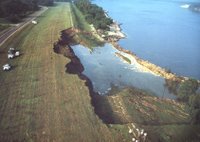 The Louisiana Senate voted 38-0 to pass a compromise bill consolidating the various levee boards into two separate boards.
The Louisiana Senate voted 38-0 to pass a compromise bill consolidating the various levee boards into two separate boards.
In Boasso's measure, the eastern portion of the flood-protection authority would include St. Bernard, St. Charles, St. John the Baptist, St. Tammany and Tangipahoa parishes, plus the portions of Orleans and Jefferson parishes on the east bank of the river. The western portion would consist of west bank parts of Orleans and Jefferson parishes.This may not be as good as the "super-board" that most people had been hoping would pass but I think it is an acceptable solution. What is important is that the existing levee boards will be disolved.
...the altered measure satisfies her top concerns about levee reform: that the new boards are staffed by scientists and that the boards focus only on flood control.Unfortunately,
The plan's sponsor, Sen. Walter Boasso, agreed to split the new "super levee board" into eastern and western parts after getting tough opposition from west bank lawmakers unwilling to vote for a plan that would have dissolved their local levee board.There is a certain logic to creating separate levee boards to deal with separate flood basins. This may work out but only if the boards don't continue or become way-stations and playgrounds for political cronies whose only interest is lining their or their friends pockets. The article doesn't address the make-up of the new Westbank board.
Stay tuned.
designed
9:53 PM
1 critiques
![]()
Monday, February 13, 2006
Don't Look At Me Dude, I'm Totally Innocent Here
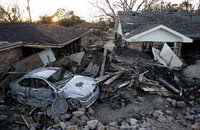 A buyout plan for flooded homes is in the works so that homeowners can finally get some financial relief. The article in the Times-Picayune is not clear about the source of the funding, but five parish presidents are in favor of this plan at least in priniciple.
A buyout plan for flooded homes is in the works so that homeowners can finally get some financial relief. The article in the Times-Picayune is not clear about the source of the funding, but five parish presidents are in favor of this plan at least in priniciple.
For those that qualify, this plan would be more generous than the Baker Bill that offered up to 60% of the homeowners equity whereas the "Failed Levees Homeowner Recovery Program", as Mayor Nagin as referred to it, will give 100% of the homeowners equity up to $150,000 minus any insurance settlement.
This is good news if it in fact comes to fruition however there a few drawbacks:
- It only applies to people whose homes received more than two feet of water. Someone with 18" of water is SOL, even though the amount of damage is the same.
- It does not address the losses by insurance companies as a result of negligence on the part of the federal government. Homeowners in the area will still be burdened by significantly higher flood insurance.
As for the many homes that flooded in Jefferson Parish due pumps not being manned, blame for that cannot be levied against the federal government, that blame goes squarely to Parish President Aaron Broussard who evacuated the pump operators - against their wishes - to Washing Parish ahead of Hurricane Katrina. During the twelve hours it took for the pump operators to return, thousands of homes flooded, most with just a few inches of water.
And as usual, when the government screws up, average citizens are left to pick up the peices and the officials responsible look for someone to pin the blame.
designed
5:04 PM
0
critiques
![]()
C'est Levee
 The Mardi Gras season kicked off on Saturday when the Krewe du Vieux held the first parade of the 2006 season. Needless to say, FEMA and state poloticians bore the brunt of their satire.
The Mardi Gras season kicked off on Saturday when the Krewe du Vieux held the first parade of the 2006 season. Needless to say, FEMA and state poloticians bore the brunt of their satire.
The Third Battle of New Orleans has more.
designed
3:54 PM
0
critiques
![]()
Friday, February 10, 2006
The New Potemkin
 Austin Williams' essay at Spiked-Online deals with New Urbanism's apostles "getting on with it with a missionary zeal" in rebuilding the Gulf Coast and engaging in the debate of whether New Orleans sould be rebuilt.
Austin Williams' essay at Spiked-Online deals with New Urbanism's apostles "getting on with it with a missionary zeal" in rebuilding the Gulf Coast and engaging in the debate of whether New Orleans sould be rebuilt.
I have news for professor of architecture Roger K Lewis, New Orleans is being rebuilt as we speak. The real question is how should we rebuild. His question was answered when residents reacted angrily when the BNOB Commission recommended a four month moritorium on issuing new building permits in the city.
So now that New Orleans is going to be rebuilt, how do we proceed? The New Urbanist's have a lot to offer but we should take Errol Barron's warning that
'it's not the [New Urbanist] aesthetic that's wrong, it's the artificiality of something planned all at once.'That's why I like, at least in concept, the master plan proposed by the BNOB Commission in that it mostly deals with improving infrastructure. Residents will react to the location of things like public transporation, schools, and recreation facilities. But they are also influenced by more intangibles like crime, economic opportunity and social interaction. Proper zoning will also help.
These things cannot be solved by simply putting the gangster in a nicer neighborhood. Rather the gangster needs to be excised from the community. That is what prisons are for.
So,
While [David Harvey's 1997 Harvard Design Magazine essay] is rather too soft in his criticism (effectively suggesting that New Urbanism's proscriptive car-reducing, underclass-taming, suburb-sprawling objectives won't work, rather than arguing that they are wrong), he still identifies the authoritarian nature of the behaviour modification obligations lurking behind its dainty facade. The Charter for the New Urbanism looks to forming 'identifiable areas that encourage citizens to take responsibility for their maintenance and evolution (where) streets and squares...enable neighbours to know each other and protect their communities.'Rebuilding the physical damage done to New Orleans is the easy part but it should be part of the long-term effort. In the short-term, let's rejuvenate the institutions that have been failing the Crescent City for the past forty years. We need a healthy soul before we can begin healing the body. Otherwise New Orleans will be again just a prety facade with a crumbling foundation.
While these sound like pleasant homilies and an innocent nostalgia for the reinvigoration of neighbourliness, there is a less tolerant aspect to the pattern-book approach of the New Urbanists, in which disharmony can be designed out and neighbourliness engineered in. Societal fragmentation is an ongoing political concern, developed by Robert Puttnam's 'Bowling Alone' thesis in the USA and recently expressed by Tony Blair's 'Respect' agenda in the UK, so it should be expected that the design remedies apparently offered by New Urbanism should gain a hearing. But the fragmentation of communities is a political problem allied to a lack of political vision; it is not a 'design issue' that can be remedied by porches, pedestrianisation or the provision of faux-French facades. Community spirit may well form in many of these newly-built, New Urban areas, but the failure to address the underlying fractiousness in society means that we may be building communities of isolated individuals, in which the appearance of unity can only be maintained by excluding those who won't play the game.
designed
3:42 PM
2
critiques
![]()
You Gotta Be Cruel To Be Kind
 "There's going to be some letting go, but sometimes we have to let go to go forward."
"There's going to be some letting go, but sometimes we have to let go to go forward."
The above quote is from Rev. Michael P. Jacques, pastor of St. Peter Claver Catholic Church, regarding The Archdiocese of New Orleans and its closing 7 of its parishes, temporarially merging about 20, and consolodating or changing many of its 107 schools. This is going to be a tough step for many New Orleanians, but like the other changes that are currently being discussed this will be a positive for the long-term health of the Catholic Church in New Orleans.If only our politicians could muster this kind of sacrifice for the better of their community.
Via: Hurricane Katriana Aftermath.
designed
11:18 AM
1 critiques
![]()
Leave Me Alone `Til I Need Your Help
 Seymour D. Fair gives his thoughts on levee-board consolidation at The Third Battle of New Orleans.
Seymour D. Fair gives his thoughts on levee-board consolidation at The Third Battle of New Orleans.
Quote:
It's no surprise the all-out consolidation probably won't fly with the state's politicians. For instance, Livingston Parish wants out. The Westbank portion of Jefferson Parish wants out. (Or at least certain politicians from these areas have voiced they don't want to reform). They'd like to see the levee boards remain over their jurisdictions stay just the way they are.Read the whole thing.
Their angle: we didn't flood during KTMB and we're happy just the way things are. It all works just fine for us. And also, this whole thing is New Orleans' problem--why should the whole state have to deal with it?
The truth is the relationship between New Orleans and the rest of Louisiana (and even the neighboring parishes to New Orleans--especially St. Bernard and Plaquemines) has always been rocky. I have always said that the City of New Orleans is a northeast-type city (the era of development, the ethnic/racial diversity, the cultural aspects, etc.) cast by itself in the rural Southern United States. The other 63 parishes have always felt slighted that New Orleans drains an unfair proportion of the state's resources and the other areas don't get their fair share. The proposed levee consolidation idea is no different in their eyes. This proposal is viewed as a power grab by the New Orleans area politicians (and therefore a power loss for eveyone else). Also, the past (from their perspective) tells them their problems will always be given the back seat to those of New Orleans and they perceive the centralized levee board as focusing primarily on the New Orleans issues while neglecting their flood protection interests and concerns.
A flooding Mississippi River or Atchafalaya River or hurricane-driven storm surging Gulf of Mexico or Lake Pontchartrain or Terrebonne Bay or Vermilion Bay knows no political boundaries or jurisdictions. Therefore, protection of Louisiana from these threats should not be impaired by political boundaries or jurisdictions. If nothing else, there needs to be an independent oversight commission to assure the flood protection elements within the various jurisdictions work in unison and also to monitor and assist the U.S. Army Corps of Engineers who ultimately has sole responsibility for Louisiana's flood protection. Hey, they decided they'd handle it--twice--in 1927 and 1965.
The West Jefferson Levee Board does have a point that in that it is in a different basin and therefore has different needs from Orleans and East Jefferson. A quick look at a map of SE Louisiana will show that a storm surge threatening the east bank poses less of a threat for the west bank and vice versa. But a major hurricane making landfall to our west will put the west bank in great peril. But west bank politicians seem to think that because they survived major flooding from Katrina that their flood protection is more than adequate for all future storms is outright baloney.
The whole southeast Louisiana region is vulnerable to storm surge and therefore storm-surge protection needs to be regional.
Take the Regolets for example. It is the waterway that connects Lake Ponchartrain to the Breton Sound and the Gulf of Mexico. Storm surge could be kept out of the lake ff a series of locks would be constructed across the Regolets that could be closed prior to its arrival thereby protecting the entire east bank and northshore from major flooding. Because the Regolets falls between the jurisdictions of the Orleans Levee Board and the St. Tammany Levee Board, it is unlikely that these two entities will get together to build something this enormous. With a single board, there will be no jurisdictional squabbles to doom such an undertaking.
The westbank on the other hand is at serious risk of a storm surge coming up the Barataria Waterway. The Harvey Canal levee has overtopped or threatened to overtop during other, during less severe storms as a result of storm surge entering the Intracoastal Waterway which connects to the Harvey Canal. Although most of the developed area of the westbank is protected by hurricane protection levees, it has the same vulnerabilities that the east bank has.
The fact that our politicians are more interested in protecting their fiefdoms than protecting their constituents means that some major housecleaning is due in the next round of elections.
designed
10:22 AM
1 critiques
![]()
Thursday, February 09, 2006
I Never Promised You A Rose Garden
Gulf Coast reconstruction czar Donald Powell got a lukewarm reception on Wednesday from a group of Louisiana bankers who challenged the former bank regulator on the speed of recovery and the true amount of federal dollars being devoted to the effort.Bankers aren't the only ones not happy with the federal government's response to the Hurricane Katrina recovery effort. Most of south Louisiana is probably ready to secede from the Union if President Bush doesn't live up to his promise to rebuild the Gulf Coast.
But Powell offered little fresh insight into the federal government's plans for south Louisiana, insisting that local decisions must guide the rebuilding effort but that Washington remains a committed partner.So now is the time for local residents to direct a lot of the pressure on our own politicians. As the second special session of the Louisian Legislature convenes, crucial issues that will determine the level of response from the federal government are being met with stiff resistance.
State Sen. Walter Boasso's, R-Arabi, bill to consolidate the various levee boards faces multiple obstacles as well as other proposals to consolidate New Orleans government.
These changes need to be made regardless of Washington's wishes and it's a shame that it takes that kind of prodding to make it happen. If change does happen, I expect President Bush to live up to his word and help us rebuild as he promised. Otherwise he'll be referred to as being all hat and no cattle around these parts. If change does not happen, Louisiana politicians will be known as dead men walking.
designed
5:19 PM
0
critiques
![]()
Wednesday, February 08, 2006
Start Me Up, With Or Without You
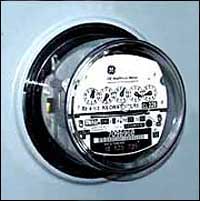 Some New Orleans homeowners are breaking the law in order to have electricity restored to their homes. That shows the level of frustration that residents are dealing with when trying to move back into the city.
Some New Orleans homeowners are breaking the law in order to have electricity restored to their homes. That shows the level of frustration that residents are dealing with when trying to move back into the city.
Vine, a building contractor, broke the law and risked serious injury or death. But like so many others in this hurricane-ravaged city, he figured it was the only way to avoid the red tape and hair-pulling frustration so many have faced in trying to get their electricity restored."People cannot possibly do this by the book and stay in the city," said Vine, who lives a block from one of the city's former mayors in the upper-middle-class Broadmoor neighborhood.
Last month I posted an article about the City of New Orleans waiving its requirement to obtain a permit prior to starting electrical work. What the article failed to mention is that inspections are still required. And therin lies the rub. You see, New Orleans has only six electrical inspectors for about 124,000 homes and businesses that were flooded. That's a helluva bottleneck.
But as usual, lawyers are throwing wrenches into the works:
"We can't waive the inspection because unfortunately the liability would be too great," said Clinton Vince, an attorney who advises the City Council's utilities committee. "The electrical work needs to be inspected because if the wire is not installed properly, it could cause serious safety problems — including loss of life."I think homeowners understand the risk posed by playing with electricity. That's why they hire electricians. At least other city administrators understands that "These are extraordinary times."
designed
10:28 PM
0
critiques
![]()
One Hero Sandwich, Hold The Mayo
 The rebuilding of the Gulf Coast and New Orleans is offering the opportunity for those of us in the design community to debate the pros and cons of Modernism and New Urbanism.
The rebuilding of the Gulf Coast and New Orleans is offering the opportunity for those of us in the design community to debate the pros and cons of Modernism and New Urbanism.
Modernists look down upon the New Urbanists as wanting an unispired Disneyification of American cities. New Urbanists see Modernists as a bunch of ego maniacs determined to strip away all that familiar to residents to build their perceived utopian societies. Both may be correct and both may be wrong. I think both sides have something to offer and it is up to us to decide learn what each side has to offer and what will work best for us.
corbusier at Architecture and Morality writes about the "...abandon(ment of) the modernist style for a historicist one." as developers and architects seek to recreate foreign environments seemingly out of place from their locale. This may be fine for resorts as they are just that, resorts. People go their to escape the familiar. And if it has to be make-believe, make it so.
That differs from where people live and work. They mostly want the familiar. When architect Marianne Cusato designed the "Katrina Cottage", many people wanted to know where could they get one. One the other hand, acedemics like Prof. Peronnet scoffed, saying it is "a decorated shed on wheels" and that we as architects should promote "responsibility to truth and technology or better yet the promotion of architects as professionals, trained to truly solve life threatening problems and not color schemes and rafter tails."
What we need to remember is that we have a responsibility to our clients, that is if we want to be considered professionals. If our clients want the familiar, it is our duty to provide it for them. If our client wants outlandish, it is our duty to provide it, as best we can. We should not be in the habit of turning up our noses at the choices of our clients, although sometimes they deserve it.
So why the upturned noses at the "Katrina Cottage"?
If (one)looked inside the Katrina cottage and saw how the space was used maximizing each square inch, he would see inventive.Furthermore:
These designs have been proven to stand up to the wind, rain and heat, that all Southerns must deal with through out the year. I can tell you with out a doubt that here in the south we love our beautiful small buildings with porches so we can sit and enjoy summer afternoons, we like overhaning roofs, they sheds rain quickly and keep our windows dry in downpours, we like big windows for viewing tranquill gardens shaded by magnificent oaks.We as architects need to get off our high-horse and show a little respect for the wishes of the people because they are the ones who suffer most when designs go wrong. So yes, I love the "Katrina Cottage" and continually kick myself for not coming up with it first.
designed
10:37 AM
0
critiques
![]()
Tuesday, February 07, 2006
NO East, No Mo'?
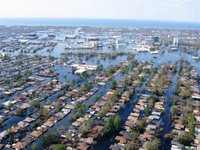 New Orleans East used to contain approximately 20% of the city's population on about 60% of the land area. Now it is mostly empty. With the exception of the reopened Home Depot, about the only activity seen today is the occasional clean-up crews, and they are now a rare sight.
New Orleans East used to contain approximately 20% of the city's population on about 60% of the land area. Now it is mostly empty. With the exception of the reopened Home Depot, about the only activity seen today is the occasional clean-up crews, and they are now a rare sight.
I was the home to many of the city's black professionals. Now they have not patients to save, not clients to serve. And the future of New Orleans is in doubt. At least that's the impression Bloomberg.com give in this article. ``It should never have been built on,'' architect Allen Eskew told me as we toured the debris-filled streets.
I think the article is unduly pessimistic. Unseen to most, some people have moved back into their homes and an entire Vietnamese community has rebuilt and moved home completely below the media radar screen.
But because of the East's light population density and large undeveloped tracks of land (such as Bayou Sauvage N.W.R.), having that part of the parish does not make any sense. As I've said in a previous post, if the city footprint needs to be reduced, a simple solution (not politically that is) is to unincorporate everything east of the Industrial Canal - except the Lower Ninth Ward and Holy Cross. However, residents who wish to return, the government should not prevent them, but they need to be aware that they will not be able to receive the same city services that they are used to.
This is not to say that NO East will be living in the Wild East, the Parish of Orleans will be obligated to provide law enforcement as well as public schools. Both of these organizations are parish wide. Entergy is not about to turn down paying customers - despite what its CEO says. The Parish of Jefferson is mostly unincorporated and yet is one of the most prosperous parishes in the state. Orleans should follow its example.
Its time for the City of New Orleans to stop talking about what needs to be done and simply do it. People are waiting for the city to take action so that they can make their decision. The indecision of the governments is what's killing us.
designed
4:28 PM
3
critiques
![]()
Monday, February 06, 2006
Good Enough For Government Work
When the federal government gets into the business of providing temporary housing for displaced residents, this is what people get: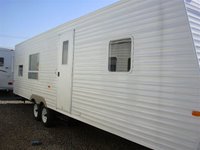
But when enterprising individuals get together to
devise a solution to the temporary housing issue, we get this: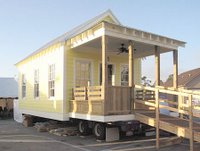
This cute little dwelling cost the same as a FEMA traier ($35,000) and has the same footprint (308 s.f.) and was built in 20 days. Mass produced, this could reasonably be halved.
A common question heard in south Louisiana is "Where is my FEMA trailer". After viewing the Katrina Cottage, as it has become known, a common question could be, "Where can I get one."
But FEMA seems to think that the trailer is all that citizens deserve, quote:The yellow cottage with a tin roof is exactly the size of the temporary trailers the Federal Emergency Management Agency provides to victims of hurricanes and other disasters, and it costs about the same: less than $35,000.
But where a FEMA trailer looks grim and dispiriting - who wants to live next to one, let alone in one? - this house, known as the Katrina Cottage, is airy, bright and charming.
"I'm designing affordable housing," said Marianne Cusato, 31, the architect who designed the cottage. But developers who toured it, she said, were telling her they want to use the plans for upscale beach cottages or mountain resorts.
FEMA, for example, is not chartered to provide permanent housing...The cottages, designed by Marianne Cusato, were originally designed to be "FEMA trailers with dignity," but have been so popular that people are inquiring about using them for hunting camps, mountain hide-aways and small vacation homes.
"Developer after developer came up to me, asking for the plans so they could build the cottage as beach-front housing or in ski resorts," she said.But:
"I insisted that this is, first and foremost, emergency housing for the people of the Gulf Coast, but that once their needs have been met, I would consider it.
"Then it hit me that what I had done was to come up with a prototype that could take off as a new way of building," she said. "The irony is that these builders never realized that affordable housing can be attractive."
Well said.
Hat tip: Veritas et Venustas.
UPDATE: Prof. David J Peronnet, RA, NCARB is not impressed and I don't care.
designed
11:29 AM
1 critiques
![]()
It Was Supposed To Do That
 The Corps of Engineers has been claiming the floodwalls that failed in New Orleans during Hurricane Katrina performed according to specifications and that the failures were due to the storm conditions exceeding the design specs. However, Engineer Manual No. 1110-2-2502 quashes that claim.
The Corps of Engineers has been claiming the floodwalls that failed in New Orleans during Hurricane Katrina performed according to specifications and that the failures were due to the storm conditions exceeding the design specs. However, Engineer Manual No. 1110-2-2502 quashes that claim.
"It says what every engineer knows: If you build walls to 14 feet, regardless of the design specifications for the expected storm -- 12 feet or 10 feet or 13 feet -- those walls must hold water to their tops," said J. David Rogers, a forensic engineer on the National Science Foundation team investigating the failures.
"That's a basic rule in engineering, whether you're building dams or floodwalls. And those floodwalls were 14 feet in New Orleans, and all the evidence says they weren't overtopped.
"So, yeah, this was a human failure, not a natural disaster."
Section 4b of the manual reads: "Case I2, Water to the Top of the Wall. This is the same as Case I1 (design flood loading) except the water level is at the top of the unprotected side of the wall."But the Corps is still stuck on stupid:
(T)he corps commander, Brig. Gen. Carl Strock, said his agency believes Katrina was a Category 4 storm when it made landfall at Buras, and was a Category 5 when it was building storm surge in the Gulf that later fell on Louisiana. Corps officials say that the floodwalls and hurricane levees were designed to withstand the equivalent of "a fast-moving Category 3 storm."
But when Congress authorized the Lake Pontchartrain and Vicinity Hurricane Protection project in 1965, the now-familiar system of ranking hurricane intensity by Categories 1-5 was not in use. Instead, the corps was directed to protect the city from what the National Weather Service called the "Standard Project Hurricane." This is a once-in-300-years storm with maximum sustained winds of 100 mph in a 30-mile radius around the eye, traveling at an average speed of 6 mph, creating a storm surge on the south shore of Lake Pontchartrain of 11.5 feet.
Investigators believe the storm-surge reached a height of 10.5 feet before the floodwalls failed, one foot below the height mandated by Congress and 3.5 feet below its designed height.
So Engineer Manual No. 1110-2-2502 is the "Go Directly To Jail" card for the engineers. It doesn't matter what Congress mandates the Corps to build, it still has to comply with engineering standards. If a client hires me to design a three-story building without exit stairs and I build it, I'm at fault for not complying with the Life-Safety Code. God help us if people die in a fire in that building.
The Corps of Engineers must think it operates under its own rules.
designed
9:06 AM
0
critiques
![]()
Sunday, February 05, 2006
On Life Support, But Feeling Much Better Now
 This is a Chicken Little moment for the Times-Picayune. Today's edition reports that, I kid you not, New Orleans hospitals are on "life support". Granted, waits at emergency rooms are extremely long and beds are in short supply. This may be difficult for the patients and the medical staff are stretched thin, but most businesses would see this as good news.
This is a Chicken Little moment for the Times-Picayune. Today's edition reports that, I kid you not, New Orleans hospitals are on "life support". Granted, waits at emergency rooms are extremely long and beds are in short supply. This may be difficult for the patients and the medical staff are stretched thin, but most businesses would see this as good news.
The only downside is that the hospitals are admitting a higher rate of uninsured, (yes, unisured DO have access to healthcare) and putting a financial strain on the institutions due to the charity system being shut-down.
The number of patients using emergency rooms for nonemergencies has a large role in the health care crisis, Peters said.
But further into the article we find that area hospitals are making adjustments to ease the load on the EDs.
In St. Bernard and Plaquemines parishes, federally financed clinics are available to residents. In Algiers, the Common Ground Collective, a grass-roots coalition, has opened a free clinic.
At West Jefferson Medical Center, the hospital has contracted with the nonprofit Jefferson Community Health Care Centers to set up an urgent-care facility outside West Jefferson's emergency room to care for patients with less serious injuries. The center takes patients on a sliding scale, meaning they pay less or nothing depending on their income and insurance.
"This is a new model of care for our community, and we're really proud of it," Muller said. "It creates access for patients, and avoids delays in the emergency room."
Carol Smith, executive director of Jefferson Community Health Centers, estimates that 65 percent of emergency room cases are not serious crises and can be handled at her facility, which opened on West Jefferson's campus in November. So far, the center is treating between 50 and 75 patients weekly, she said.
Such facilities not only provide immediate relief to area hospitals, but also to patients such as Tom Northrop, who suffered a paralyzing muscle spasm recently in Uptown New Orleans.
These urgent-care facilities are a somewhat recent concept in the healthcare industry. A number of hospitals, though not enough, are creating the facilities to to ease the demand on the costly ED and provide a shorter wait-time for the patient. The post-Katrina New Orleans now sees these as more necessary than ever.
But the problem could have been aleviated years ago if the Charity Hospital system in Louisian had been far-sighted enough to build these before. Because those unable to pay for healthcare were forced to go to the ED instead of their doctor, many chose not to receive proper care or those that did went to t0 the ED unnecessarily. Now DHH is looking into rebuilding a much smaller Charity Hospital along with numerous and smaller community clinics where residents can have shorter wait times closer to home and not be a burden on the much more expensive ED.
A few weeks after the storm, Congressman Bobby Jindal - (R) LA wrote an OpEd in September, 2005 challenging the state to rebuild our healthcare system as the best in the country.
The healthcare system has a great need for community-based outpatient, electronic patient records, bar coding of medical supplies and prescription drugs, and portable private insurance products that encourage patient empowerment.These technologies are here already, we just need to spend the money to implement it.
We should listen to what Congressman Jindal has to say, not the Times-Picayune.
UPDATE: University Hospital will be opening about 14 ED bays in its now closed facility.
designed
10:21 PM
0
critiques
![]()
Saturday, February 04, 2006
Oops!
 A litle error has huge consequences. According the Times Picayune:
A litle error has huge consequences. According the Times Picayune:
A difference in soil-boring data transferred from one chart to another may have played a key role in engineering decisions that led to the breach on the 17th Street Canal floodwall during Hurricane Katrina, National Science Foundation investigators say.We all make mistakes, but doesn't anyone at these engineering firms check the work of another, especially when failures can be deadly.
A cross-section drawing in the project design documents shows a weak layer of peaty soils between 11 feet and 16 feet below sea level in the area that failed during the storm. But information in the individual soil borings that were used to draw the cross section show the peaty layer extending as deep as 30 feet below sea level.
Investigators also have been puzzled by what they say are obvious engineering errors because the firms involved -- Eustis Engineering for the soil profiles, Modjeski and Masters for the general design -- were experienced and reputable in their fields. Work by the National Science Foundation team, however, may have uncovered a small mistake that had a huge impact.
designed
11:16 PM
0
critiques
![]()
Thursday, February 02, 2006
Too Old To Die!
 The National Trust for Historic Preservation in New Orleans and The Preservation Resource Center are attempting to prevent the demolition of many buildings in New Orleans deemed to be historic.
The National Trust for Historic Preservation in New Orleans and The Preservation Resource Center are attempting to prevent the demolition of many buildings in New Orleans deemed to be historic.
Next, the city hopes to demolish about 1,900 other buildings because they are deemed in danger of collapsing. The preservationists have looked at 199 of those buildings in the city's historic districts-many of them Creole cottages and cypress shotgun homes, trademark New Orleans structures based on French Caribbean and West African designs. The preservationists believe 71 are structurally sound and another 29 may be salvageable.
It looks the city and the preservationists have reached an agreement that is probably reasonable:
Greg Meffert, a city official who oversees permits and safety, said opponents to demolitions would have about three months to prove buildings should be removed from the demolition list. He said buildings that are found to be structurally sound could be saved.
While it would be a shame to demolish these historic structures, if they are indeed beyond repair, the city really has no choice to tear them down. The loophole that the preservationist have is that in order to be deemed beyond repair, often the inspectors will consider the cost of repair to greater that 50% the value of the building. Which is probably the case. The way out for the preservationist is to promise to the city is that a number of preservation organizations and individuals have pledged money to pay for the cost for repair. Assuming they have access to that kind of money. If I were them, I would immediately start requesting pledges from those interested and work out a deal.
In my experience, people in Safety & Permits can sometimes be pretty reasonable, if you talk nice to them. I'm sure the people in government would like to see historic building remain too.
designed
9:41 PM
0
critiques
![]()
Half A Loaf Is Not As Good As A Whole
 Lolis Eric Elie asks a good question:
Lolis Eric Elie asks a good question:
The Baker bill has all but achieved that status of a sacred text. It has become the rock on which our state is planning its rebuilding. But is our faith in it well-placed?In a previous post, I urged people to support the Baker Bill. Being that it is the only plan to make homeowner financially whole, I am willing to accept a few warts. When the White House announced its opposition, South Louisianans faces turned red. I even sent an email to the White House stating my displeasure. And I'm a Bush supporter.
Here Mr. Elie makes an excellent point. Accepting the Baker Bill would be like taking a $1,500 settlement from the insurance company of the person who just totaled you Mercedes and sent you to the hospital to two-weeks. In other words, we deserve more. After all, it was negligence on the part of the federal government that resulted in the flooding of the city.
If homeowners who were flooded, even some who weren't, are able to sue the federal government - and that's a big if - the should be able to get a settlement worth hundreds of thousands of dollars. That's a lot better that 60 - 80% of the value of your home (assuming you still have a home).
When President Bush said that he needed a plan from the state, maybe that's what he had in mind? If it is, Louisiana need to bring a mindreader with them next time they visit Washington. What they'll probably do is continue to hold out their hand saying "Oh woe is us."
designed
9:13 PM
0
critiques
![]()















